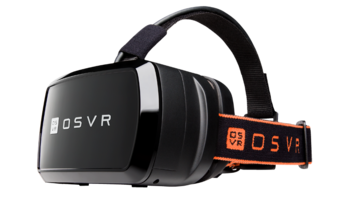Difference between revisions of "OSVR HDK1"
Shadowdawn (talk | contribs) |
Xinreality (talk | contribs) |
||
| Line 12: | Line 12: | ||
|Tracking=3DOF | |Tracking=3DOF | ||
|Rotational Tracking=[[Gyroscope]], [[Accelerometer]], [[Magnetometer]] | |Rotational Tracking=[[Gyroscope]], [[Accelerometer]], [[Magnetometer]] | ||
| − | |Positional Tracking=IR-LED faceplate and Infrared Camera | + | |Positional Tracking=IR-LED faceplate and Infrared Camera, Dual-camera Faceplate and Dual Camera System |
|Update Rate=?? | |Update Rate=?? | ||
|Latency=?? | |Latency=?? | ||
Revision as of 10:31, 28 April 2015
| OSVR HDK1 | |
|---|---|

| |
| Basic Info | |
| Type | Virtual Reality |
| Subtype | Head-mounted Display |
| Platform | OSVR |
| Developer | Razer |
| Release Date | June, 2015 |
| Price | $200 |
| Website | OSVR Hardware |
| System | |
| Storage | |
| Display | |
| Display | 5.5 inch OLED |
| Resolution | 1920 x 1080, 960 x 1080 per eye |
| Refresh Rate | 60 Hz |
| Image | |
| Field of View | 100° (nominal), 90° (H and V) |
| Optics | |
| Tracking | |
| Tracking | 3DOF |
| Rotational Tracking | Gyroscope, Accelerometer, Magnetometer |
| Positional Tracking | IR-LED faceplate and Infrared Camera, Dual-camera Faceplate and Dual Camera System |
| Update Rate | ?? |
| Latency | ?? |
| Audio | |
| Connectivity | |
| Connectivity | 1 external USB, 2 internal USB |
| Device | |
| Input | Various Controllers, Leap Motion |
OSVR Hacker Dev Kit is a Virtual Reality head-mounted display created by Razer. Hacker Dev Kit is the OSVR's first device. It was announced in GDC 2015 alongside Razer's VR Platform Open Source Virtual Reality or OSVR. OSVR Hacker Dev Kit has an open source and modular design that not only allows the user to replace and renew its hardware components but also build one from scratch. The schematics is available for free on OSVR's website.
Hardware
Hacker Dev Kit or HDK is open sourced just like its software counterpart. Users can freely download its schematics from OSVR's website. It is ideal for users who like to build their own or make modifications to the pre-existing device. HDK has a modular design that allows the users to replace old components with newer versions or customize them.
On March 25, 2015, OSVR announced that it will have an optional faceplate with Leap Motion hardware and software incorporated. This faceplate allows the HMD to accurately track the movement of hands and fingers.
Specifications
| Part | Spec |
|---|---|
| Display | 5.5 inch OLED |
| Resolution | 1920 x 1080, 960 x 1080 per eye |
| Refresh Rate | 60 Hz |
| Field of View | 100° (nominal) 90° (Horizontal and Vertical) |
| Interaxial Distance | Adjustable |
| Tracking | 6 degrees of freedom |
| Rotational Tracking | Gyroscope, Accelerometer, Magnetometer |
| Positional Tracking | IR-LED faceplate and Infrared Camera or Dual-camera Faceplate and Dual Camera System |
| Update Rate | |
| Latency | |
| Input | Various, such as Controllers, Leap Motion, Nod |
| Connectivity | 1 external USB, 2 internal USB |
| Weight |
Components
HMD Module - Where all the sensors are located. It has 3 USB 3.0 ports, 2 internal and 1 external.
Display - Display with flat cables and display board interface for interchangeable panels.
Optics Module - Two-lenses optics for additional eye pressure relief, Free from strong geometrical distortion (<13%), Adjustable inter Pupillary Distance and Diopter for use without glasses
HMD Mechanical Module - Replaceable face mask with foam layer for comfort.
Belt Box Module - USB 3.0 port, integrated surround sound, effortless cable management and signal boosters.